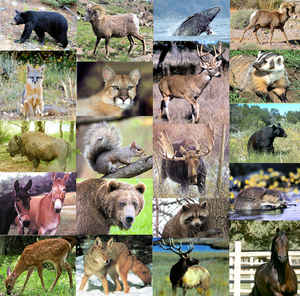Maine State Animal
Moose

(Alces alces)
Adopted in 1979
The Moose, (Alces alces,) was adopted as the Maine state animal in 1979. Moose, black bear, and white tailed deer are the three top big game animals in the state of Maine.
The moose is the world's largest member of the deer family. Moose mostly inhabit northern forests of North America, Europe, and Russia (in Europe they are called "elk")
Maine State Animal: Moose

The moose (North America) or Eurasian elk (Europe), (Alces alces) is the largest extant species in the deer family. Moose are distinguished by the palmate antlers of the males; other members of the family have antlers with a dendritic ("twig-like") configuration. Moose typically inhabit boreal and mixed deciduous forests of the Northern Hemisphere in temperate to subarctic climates. Moose used to have a much wider range but hunting and other human activities greatly reduced it over the years. Moose have been reintroduced to some of their former habitats. In North America it is found in wooded areas of Canada and the northern United States. Maximum size of a bull may stand more than 6 ft high at the shoulder and weigh more than 1400 lbs. Their diet consists of both terrestrial and aquatic vegetation. The most common moose predators are wolves, bears, and humans. Unlike most other deer species, moose are solitary animals and do not form herds. Although generally slow-moving and sedentary, moose can become aggressive and move surprisingly quickly if angered or startled. Their mating season in the autumn can lead to spectacular fights between males competing for a female.
The males bear enormous, broad, flattened antlers with prongs, or tines which can can attain a spread of 5 ft. or more. The antlers are shed each year after the mating season.

The body color of the moose varies from almost black to light brown, becoming greyish in winter. The legs are lighter in color than the body. The protruding muzzle and the long legs enable the animal to browse on brush and to wade into lakes and ponds to feed on aquatic plants. The shoulders of the moose are higher than the hindquarters, giving it a humpbacked appearance that is accentuated by the short neck.
In order to reach low-growing plants or to drink from a shallow pool, the moose is forced to kneel. It is an excellent swimmer. Moose generally are solitary, although they may form into small bands in winter and trample down the snow where good cover exists, making a moose yard where the animals stay while the food lasts.
During the mating season, bulls battle for the cows, and their roars may be heard for great distances. After a gestation of eight months, one to three calves are born; they stay with the mother for two years.
Thirty (30) interesting Moose facts.
- Moose are the official state animal of Maine.
- Male moose are called Bull Moose.
- Only Bull Moose has antlers.
- Bulls' antlers can span up to 6 feet wide and weigh up to 90 lbs.
- Bull Moose shed their antlers every winter and grows them back every spring.
- Each year a moose grows bigger antlers than the year before.
- Bull Moose grow antlers to impress cows during mating season and to express dominance in the pack.
- Moose have the highest rate of bone formation growth; growing up to 1 inch a day.
- During mating season Bull Moose are more aggressive.
- Moose live for an average of 25 years and can weigh up to 1500 lbs.
- Moose on average are 7 feet tall at the shoulders and 8.5 feet in length.
- Moose are great swimmers and can swim up to 6 mph.
- Moose can run up to 35 mph.
- Female moose are called "cows".
- Female moose (cows) are pregnant for 8 months.
- Infant moose are called "calves".
- Baby moose are an average of 25 - 33 lbs when born.
- Calves will stay with their mom until they are 1 year old.
- Moose have bad eyesight.
- Moose have 32 teeth.
- Moose have no upper front teeth.
- Moose have front legs that are longer than their back legs.
- Moose have 27 chromosomes. Humans have 23.
- The flap that hangs under the moose's throat is called a "Bell".
- Moose are the largest member of the deer family.
- There is such thing as a white moose, however it's extremely rare, and is not considered an albino.
- Like a dog, when moose are agitated the hairs on their backs stand up straight.
- Maine has the second highest population (30,000) of moose in the U.S., next to Alaska.
- May, June, September, October and December are the best moose watching seasons in Maine.
- You are more likely to see a fully antlered Bull Moose in September and October. (This is right before they shed them for the winter)
Maine Law
The law designating the moose as the official Maine state animal is found in the Maine Revised Statutes, Title 1, Chapter 9, Subchapter1, Section 215
Title 1: GENERAL PROVISIONS
Chapter 9: SEAL, MOTTO, EMBLEMS AND FLAGS
Subchapter 1: GENERAL PROVISIONS
§215. STATE ANIMAL
The state animal shall be the moose. [1979, c. 234, (NEW).]
SECTION HISTORY
1979, c. 234, (NEW).
Taxonomic Hierarchy: Moose
Kingdom: Animalia
Phylum: Chordata
Class: Mammalia
Order: Artiodactyla
Family: Cervidae
Subfamily: Capreolinae
Genus: Alces - Gray, 1821
Species: A. alces








